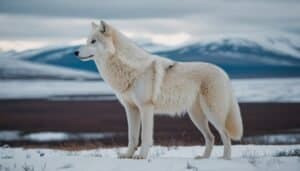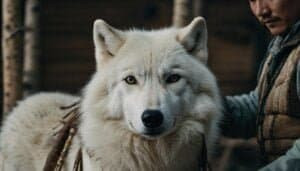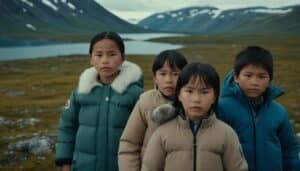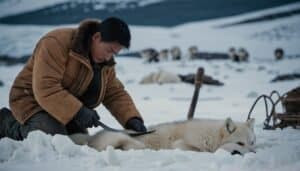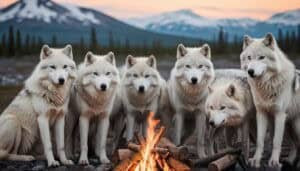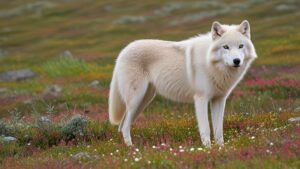Introduction
The Arctic wolf, a majestic and resilient creature, holds profound significance in the legends and myths of indigenous Arctic peoples
This article delves into the cultural and spiritual symbolism of the Arctic wolf, exploring its role in daily life, spiritual practices, and storytelling traditions. We will examine the Arctic wolf’s depiction in myths, its influence on art and modern adaptations, and the varying perspectives among different tribes
The Cultural Significance of the Arctic Wolf
Historical Context and Reverence
The Arctic wolf, also known as Canis lupus arctos, has long been a significant figure in the lives of indigenous Arctic peoples
These communities, including the Inuit, Chukchi, and other groups across the Arctic regions, have historically revered the Arctic wolf not only for its strength and survival skills but also for its close resemblance to humans in terms of social structure and cooperation. The wolf’s ability to thrive in the harsh Arctic environment made it a symbol of resilience and adaptability
Indigenous peoples have often seen the Arctic wolf as a guide and protector. In many cultures, wolves are considered ancestors or spiritual guides, bridging the gap between the human and animal worlds. The reverence for the Arctic wolf is deeply embedded in the spiritual and cultural practices of these communities
For instance, Inuit hunters might perform rituals to honor the spirit of the wolf, believing that this would bring success in their hunts and ensure harmony with the natural world
Arctic Wolf in Daily Life and Practices
The Arctic wolf’s influence extends into the daily lives and practices of indigenous Arctic peoples. Traditionally, the wolf has been a source of inspiration for survival strategies. Observing wolves’ hunting techniques and social behaviors provided valuable lessons for human communities
This symbiotic relationship is reflected in the ways that hunting and gathering practices often mimic the cooperative strategies of wolf packs
Additionally, the Arctic wolf appears in various aspects of daily life, from the creation of clothing and tools to storytelling and oral traditions. Wolf fur and bones were historically used in clothing and tools, signifying the animal’s integral role in the survival of the people
Moreover, stories about wolves are common in the oral traditions of Arctic cultures, often serving as educational tools to teach younger generations about important cultural values and survival skills
Influences on Art and Storytelling
The cultural significance of the Arctic wolf is vividly expressed in the art and storytelling of indigenous Arctic peoples. Wolves frequently appear in carvings, paintings, and other forms of visual art, symbolizing various spiritual and cultural themes
For example, intricate carvings on ivory, bone, and stone often depict wolves alongside other significant animals, each figure representing different aspects of the natural and spiritual world
Storytelling, a cornerstone of indigenous Arctic cultures, often features the Arctic wolf in prominent roles. These stories are not merely tales of adventure but carry deeper meanings and lessons
For instance, a common motif in Arctic wolf stories is the theme of transformation, where wolves might change into humans or other animals, highlighting the interconnectedness of all living beings. These stories also often emphasize the importance of community, cooperation, and respect for nature, mirroring the social structures observed in wolf packs
Spiritual Meanings of the Arctic Wolf
Symbolism in Dreams and Visions
In the spiritual beliefs of indigenous Arctic peoples, the Arctic wolf often appears in dreams and visions, carrying deep symbolic meanings. Dreams involving wolves are generally seen as powerful omens or messages from the spirit world
A wolf appearing in a dream might be interpreted as a sign of guidance, protection, or a call to embrace certain qualities such as loyalty, courage, and strength. In some traditions, dreaming of a wolf could also suggest a connection to a specific ancestor or spiritual guide, indicating a strong bond between the dreamer and the spirit realm
Visions of Arctic wolves are considered significant spiritual experiences, often occurring during rituals or in states of heightened spiritual awareness. These visions might be interpreted by shamans or spiritual leaders, who can provide insight into their meanings and implications for the individual’s life and community. The appearance of a wolf in a vision is often seen as a blessing, signaling the presence and support of spiritual forces
Role in Spiritual Beliefs and Practices
The Arctic wolf plays a crucial role in the spiritual beliefs and practices of many indigenous Arctic communities. It is often viewed as a totemic animal, representing a clan or individual’s spiritual identity and heritage. Totemism involves the belief that humans have a mystical relationship with a spirit-being, such as an animal or plant, which serves as a guardian or protector
In many Arctic cultures, the Arctic wolf is revered as a powerful totem animal. It is believed to possess qualities that individuals or clans seek to embody, such as leadership, resilience, and unity. Rituals and ceremonies often include honoring the wolf spirit, asking for its guidance and protection. For example, during hunting rituals, offerings might be made to the wolf spirit to ensure a successful hunt and to show respect for the animal’s life and spirit
Connections to Totemic Systems
Totemic systems are an integral part of the spiritual landscape of indigenous Arctic peoples, and the Arctic wolf is a prominent figure within these systems
Totems serve as emblems of family, clan, or tribe identity, and are believed to have a direct influence on the lives and fortunes of the people who bear them. The Arctic wolf, with its keen hunting skills and strong family bonds, is often chosen as a totem for its embodiment of desirable traits
In these totemic systems, each totem animal is believed to impart its characteristics to the individuals or clans it represents. The Arctic wolf’s attributes, such as its keen instincts, strength, and cooperative nature, are qualities that people strive to emulate
Totemic rituals and symbols often feature the Arctic wolf prominently, reflecting its importance in the spiritual and social fabric of the community. These practices help reinforce the bond between the people and their environment, fostering a sense of unity and continuity with the natural world
The Arctic Wolf in Myths and Legends
Creation Myths Involving the Arctic Wolf
In the rich tapestry of indigenous Arctic mythology, the Arctic wolf often plays a pivotal role in creation myths. These stories are foundational narratives that explain the origins of the world, human beings, and other elements of existence. The Arctic wolf is frequently depicted as a creator or a guide who brings order to the world
For instance, among some Inuit tribes, there are myths that describe how the Arctic wolf helped shape the land and taught humans essential survival skills. One popular creation myth tells of a time when the world was covered in darkness and chaos
The Arctic wolf, endowed with great wisdom and power, emerged to bring light and order. It is said that the wolf howled at the sky, breaking the darkness and bringing forth the moon and stars. This act not only illuminated the world but also established the rhythm of night and day, enabling life to thrive
Famous Stories and Their Meanings
Beyond creation myths, the Arctic wolf appears in numerous other legends and stories, each carrying profound meanings and lessons. These tales often serve to reinforce cultural values, teach moral lessons, and explain natural phenomena
One well-known story is that of “The Wolf and the Raven.” In this tale, a wise Arctic wolf befriends a clever raven. Together, they navigate various challenges, each using their unique abilities to outsmart dangers and find food. The story highlights the importance of cooperation, intelligence, and mutual respect, reflecting the interdependent relationship between different species and the environment
Another significant legend is “The Lone Wolf’s Journey,” which tells the story of a young wolf who sets out on a quest to find his place in the world. Through trials and encounters with other animals, the lone wolf learns about bravery, self-discovery, and the importance of community. This story is often told to young members of the tribe to emphasize the value of perseverance, self-reliance, and the eventual return to the community with newfound wisdom
Differences Among Various Tribes
While the Arctic wolf holds a place of honor across many indigenous Arctic cultures, the specific stories and the nature of its symbolism can vary significantly among different tribes. Each tribe has its unique myths, reflecting their distinct experiences, environments, and cultural priorities
For example, among the Inuit, the Arctic wolf is often seen as a guide and protector. Inuit stories frequently emphasize the wolf’s role in helping humans navigate the harsh Arctic landscape. Conversely, among the Chukchi people of Siberia, the wolf might be depicted more as a cunning trickster, embodying both positive and negative traits to teach lessons about the complexities of life and human nature
The diversity in these myths and legends underscores the rich cultural mosaic of the Arctic peoples and their deep connection to the natural world. Each tribe’s stories contribute to a broader understanding of the Arctic wolf’s multifaceted role in indigenous cultures, illustrating how a single animal can embody a wide range of meanings and lessons
The Arctic Wolf in Modern Indigenous Culture
Contemporary Adaptations and Symbolism
In modern times, the Arctic wolf continues to be a significant symbol for indigenous Arctic peoples, albeit with contemporary adaptations
The traditional stories and myths have evolved, blending with modern narratives to keep the cultural significance of the Arctic wolf alive. In contemporary indigenous art, literature, and media, the Arctic wolf often appears as a powerful emblem of identity and resilience
Artists and writers from indigenous Arctic communities frequently use the Arctic wolf to convey messages about environmental stewardship, cultural heritage, and social issues. The wolf’s image can be found in paintings, sculptures, and digital art, symbolizing the enduring spirit and strength of indigenous peoples
These contemporary representations serve to educate and inspire both indigenous and non-indigenous audiences about the importance of preserving cultural traditions and the natural environment
Role in Modern Art and Media
Modern indigenous artists and creators have embraced the Arctic wolf as a central figure in various forms of media. In film and literature, the wolf often appears in stories that address themes of survival, community, and the relationship between humans and nature. Documentaries and films produced by or about indigenous Arctic communities frequently feature the Arctic wolf, highlighting its role in both historical and contemporary contexts
For example, in recent years, there have been several documentaries focusing on the wildlife of the Arctic, where the Arctic wolf is showcased as a keystone species
These films not only depict the ecological importance of the wolf but also delve into its cultural significance for indigenous peoples. Through these visual and narrative forms, the Arctic wolf continues to be a potent symbol of the Arctic’s natural and cultural landscapes
Preservation of Traditional Beliefs
Despite the pressures of modernization and globalization, many indigenous Arctic communities actively work to preserve their traditional beliefs and practices involving the Arctic wolf
Cultural preservation initiatives, such as storytelling festivals, educational programs, and community gatherings, play a crucial role in keeping these traditions alive. Elders and cultural leaders pass down stories and rituals to younger generations, ensuring that the symbolic importance of the Arctic wolf is not lost
Organizations dedicated to cultural preservation often collaborate with schools and universities to include indigenous knowledge in educational curricula. By integrating traditional stories and the symbolism of the Arctic wolf into contemporary education, these initiatives help foster a sense of pride and continuity among indigenous youth
This not only strengthens cultural identity but also promotes a broader understanding and appreciation of indigenous cultures among the wider population
Conclusion
The Arctic wolf, a resilient and majestic creature, holds profound significance in the myths, legends, and spiritual practices of indigenous Arctic peoples. Its symbolism spans across various aspects of life, from cultural reverence and daily practices to spiritual beliefs and modern adaptations
Historically, the Arctic wolf has been revered for its strength, adaptability, and social structure, which mirror the values and survival strategies of indigenous Arctic communities. This reverence is deeply embedded in their rituals, art, and storytelling, where the wolf often appears as a guide, protector, and symbol of unity
Spiritually, the Arctic wolf plays a crucial role in dreams, visions, and totemic systems. It is seen as a powerful spiritual guide, embodying qualities that clans and individuals aspire to. The wolf’s presence in spiritual practices reinforces the connection between humans and the natural world, fostering a sense of respect and harmony
In myths and legends, the Arctic wolf is a prominent figure in creation stories and moral tales. These narratives not only explain natural phenomena but also teach valuable lessons about community, cooperation, and resilience. The diversity in these stories among different tribes highlights the rich cultural mosaic of the Arctic peoples
In modern times, the Arctic wolf remains a potent symbol of cultural identity and resilience. Indigenous artists, writers, and filmmakers continue to use the wolf to convey messages about environmental stewardship, cultural heritage, and social issues. Efforts to preserve traditional beliefs and practices ensure that the symbolism of the Arctic wolf is passed down to future generations, maintaining its relevance in contemporary indigenous culture
The enduring presence of the Arctic wolf in the cultural and spiritual life of indigenous Arctic peoples underscores its importance as a symbol of strength, unity, and continuity. As we explore and appreciate these rich traditions, we gain a deeper understanding of the intricate connections between humans and the natural world in the Arctic regions


